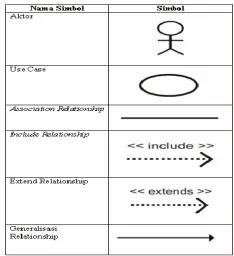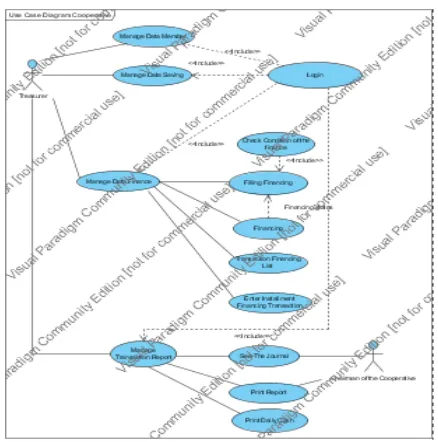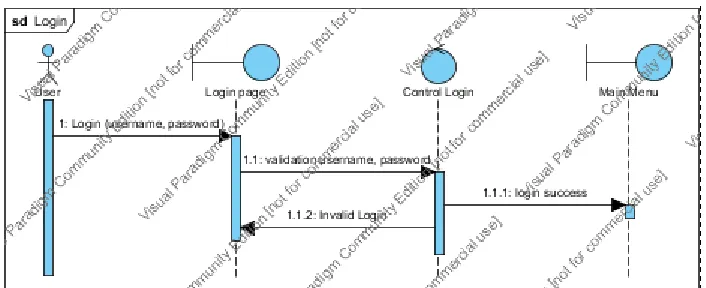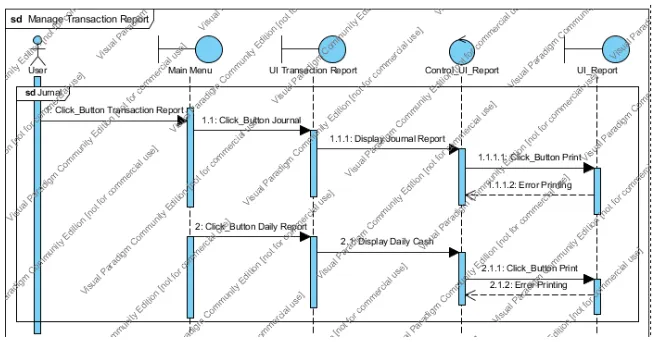Design of the Information System for the Management of Sharia Financial Services Cooperative
Authors :
Kiayati Yusriyah (Gunadarma University, Indonesia) kiayati@staff.gunadarma.ac.id
Budiman (Gunadarma University, Indonesia) budiman@staff.gunadarma.ac.id
Dharmayanti (Gunadarma University, Indonesia) dharmayanti@staff.gunadarma.ac.id
Abstract
This study aims at designing of an information systems of Sharia Cooperative Financial Services that emphasizes the concept of profit sharing. The system development life cycle approach is used with the special reference to the application of object-oriented programming using UML (Unified Modeling Language). The designed information system is based on the user requirements and in accordance with the existing business processes. The system provides capability to ease the systematic documentation, faster administration service, increase the effectiveness by reducing erroneous in data transactions and recording. By implementing the information system, it is expected that the cooperative has more capability to increase its performances and thus provide better contribution in alleviating poverty of the community under its operations.
Key words : Sharia financial services cooperatives, information systems.
INTRODUCTION
Economic empowerment through cooperatives and Small Medium Enterprises is still a top priority of long-term national economic development in Indonesia.By considering that the people's economy is generally based on local economic resources, the economic development of the people believed to strengthen the foundation of the national economy.
communities to realize economic life which has the characteristics of democracy, unity, kinship and openness.
Cooperative development in Indonesia is influenced by the social conditions of the people of Indonesia.Central Statistics Agency (BPS) reported a high number of poor people in Indonesia that as many as 28.3 million people, or 11.25% of the total population of Indonesia in March 2014.To reduce the level of poverty, then many organizations establish sharia cooperative.
In the case of Indonesia, some of Islamic cooperatives are in the form of BMT (Baytul Mal wa al-Tamwil). Furthermore, a number of researches have attempted to analyze the impact of financing given by Islamic cooperatives and BMT to micro and small scale entrepreneurs. Astuti (2007) for instance, has evaluated level of business income of the micro entrepreneurs before and after receiving financing from BMT Beringharjo Kauman, Yogyakarta. Astuti finds that the financing given has increased income of the micro entrepreneurs from Rp 190,600,- to Rp 316,000,-.
Hidayat (2004) finds that financing provided by an Islamic cooperative, namely BMT Koppontren Hubbul Wathon, West Java, has increased income level of micro entrepreneurs by 90 percent. There are only 6.67 percent claiming that there is no change in their post-financing income. The remaining 3.33 percent acknowledge that their income has decreased.
In Saudi Arabia, Obaidullah and Tariqullay (2008), said that with an estimated 650 million Muslims living on less than $2 a day, finding sustainable Islamic models could be the key to provide financial access to millions of Muslim poor who strive to avoid financial products that do not comply with Sharia (Islamic Law).
Theologically, sharia is based on the existence of cooperative Qur'an Surah al-Maidah verse 2, which advocate for helping others in goodness and forbid vice versa.Cooperative sharia contains two elements within it, namely “ta aurun” (mutual help) and “shirkah” (cooperation). Thus, cooperatives commonly called “syirkatu at tauniyyah”, which is a form of cooperation between people of mutual help members to improve the common welfare.
Cooperative is a cooperative business activities engaged in financing, investment, and savings in accordance pattern of results (sharia).Basic principle of cooperative is on strong cooperation among members. Monopolistic practices will not take place since profit and loss are shared among the members. Members’ annual meeting is the highest forum in which all strategic decisions are made. Each member has equal vote and opportunity to express idea and opinion. According to Buchori (2009), there are five major characteristics of Islamic cooperative. Firstly, acknowledging member’s ownership right on business capital. Secondly, riba-based transactions are not allowed in any circumstances. Thirdly, institution of ZISWAF (zakat, infak, sadaqah and waqf) is functioning well. Fourthly, admitting profit-oriented motive as long as sharia principles are strictly followed. Fifthly, acknowledging freedom of business and economic endeavors. Sixthly, acknowledging common rights.
Sharia Cooperative in Srengseng Sawah, South Jakarta - Indonesia, conducts its operations since 2011.These cooperative activities are dispersed held in small consultation meeting groups called “rembug”.There are 13 rembuginthe village Srengseng Sawah. Each rembug activities held once a week for an hour with a different schedule. Formation of rembug members is done in order to reach the location of activities without having to incur the cost of transportation. The Treasurer of Cooperative will accompany the rembug activity on schedule.
The products offered in this cooperative are savings and financing. Savings consists of a primary savings paid once for a member, mandatory savings is paid once a month and voluntary savings.Type of financing consists of Mudharabah, Musharaka, murabaha, ijara and instant funds. Mudharabah is a venture capital partnership agreement which the co-operative as the owners of capital (Sohibul maal) and a member of the fund manager (mudharib) to do business with the profitsharing according to the agreement in advance.Musharaka is a type of financing that is used for venture capital partnership. For those who paid to cooperative results adjusted by the ratio of the percentage of profit. Murabaha is a type of financing for purchasing consumer goods. Ijara is the financing used to rent a place or a tool that is used for business. Instant fund is a type of financing for businesses that are sudden and repayment process is also fast.
and SMEs in Yogyakarta, Central Java, Indonesia, Suprayitno (2007) says the reason that computer is not used because they don’t feel the need (82.2%), limited financial support (41.1%), and becausethey don’t have the expertise to use (4.1%).
RESEARCH OBJECTIVES
This research aims to generate of design information systems applications that can improve the performance of Cooperative Financial Services Sharia in Village Srengseng Sawah, South of Jakarta - Indonesia. The design is built to provide solutions of the problems that have been identified previously and is expected to help the performance of cooperative management in the member registration process, savings process, financing and reporting processes.
METHOD
The system development method is Object Oriented with sequential waterfall model strategy system consisting of a beginning (initiation system), systems analysis, system design and implementation of the system. But in this study is limited only to the design of the system. This design uses software Unified Modeling Language (UML).
INITIATION SYSTEM
Financial cooperatives in village Srengseng Sawah, south of Jakarta – Indonesia, stood since 2009, but until 2010 looking for shapes in the cooperative. Until the end of the month of February 2011 is oriented to the sharia and the annual members' meeting on January 14, 2011 it was decided to operate sharia. The cooperative has disbursed grants from third parties amounted to Rp 125 million to the poor in village Srengseng Sawah through business financing.
Cooperative conducts activities ina consultation meeting group called rembug. This cooperative has 116 members in 13 rembug.With the use of rembug systems, the members do not need to spend the cost of transportation to follow the activities of the group. Group activities is conducted in the house of one member once a week for an hour. The treasurer attendsthe rembugactivity on schedule.
ofrembugandthe treasurer. In the discussion, usually discussed problems faced by members of the group, and then carried out the search for solutions. With the situation of kinship, solidarity and the spirit of helping each other, then members of rembug has a solid bond.
SYSTEMS ANALYSIS
1. Members Acceptance System
Prospective members must attend at least two meetings to get acquainted with the other members in the same rembug, to see rembug activity, and to learn the cooperative business process. At the third meeting he is allowed to register as a member of the cooperative. The registration process begins by filling out the registration form. Required data is self-identity as ID, name rembug followed, the type of work done. After prospective members submit a registration form, then the treasurer issues a consent form that must be signed by all members in the same rembug. It is done related to the system called tanggung renteng, defined joint responsibility. The joint responsibility system will be used when a member is unable to return the loan, then the burden of the responsibility is belong to the other members in the same rembug. Therefore, approval of the entry of new member by other members is a rigorous selection process. The new member has to pay Rp 100,000 as primary savings for getting Member Book with identification number of member.
2. Savings Process
There are three types of savings. The first is compulsory savings of Rp 10,000, - per month. The second is voluntary savings. Compulsory savings and voluntary savings are accumulated into balances that would be a prerequisite of filing financing. The third savings is wadiah.Wadiah is the savings that can only be taken within a certain time.Wadiah that is already running, is educational savings that can be taken each semester for the needs of school children. Wadiahfor Idul Fitri can only be taken per year before Idul Fitri. Wadiah or the trust is aproposed by the members, so there is no obligation for the cooperative to pay the profit sharing.
3. Financing
value that can be submitted for any financing is the amount of three times the value of savings.The maximum value for the first financing is Rp 600,000, -. When it is paid off, then the maximum value for the second financing is Rp 1,500,000 with a minimum value of savings Rp 500,000. If the second financing is paid off, then the maximum value of the third financing is Rp 3,000,000 with minimum savings Rp 1,000,000. The maximum value of the fourth and so financing is Rp 5,000,000.
A member who will submit financing must write a letter requesting financing.Based on this letter, all the members present in rembug must sign a financing approval. This is related with joint responsibility system.
4. Process in General
Members who will save up and pay installments must fill out a slip which consists of two layers. Treasurer will check the data, and then perform the validation by signing the sheet.Treasurer save the first layer slip (white), while the second layer slip (yellow) will be given to members.Transaction data is also recorded in the Member Book and signed by the treasurer.All activities are still done manually.
5. Weaknesses of the current system
After analyzing the current system, there are some drawbacks, such as: 1) the manual system used 2) the difficulty in finding the data members. 3) the security of transaction data 4) there is only one steward who intensively to record all types of transactions, the treasurer. 5) The slow performance of the chairman in making the report.
6. Troubleshooting analysis
From the results of the issuesreview that have been described, the research propose to design cooperative information systems (picture 1) that can facilitate the process of member registration, savings and the process of financing in Islamic financial services cooperative in Srengseng Sawah, south Jakarta. This application is only used by the treasurer and the chairman.
conducted in the activities of rembug that lasted just one hour. When the number of rembugmembers is increasing, the more time it takes. 2) the treasurer can manage member and financing data easily 3) the treasurer can manage transactions data and preparing daily cash reports. 4) it can improve service and trust members of the cooperative.
Picture 1. The proposed system Prospective member
Fill out and submit the member registration form
Fill out and submit the consent form
Treasurer
member saving
filed financing
pay installments
Information system of Sharia Cooperatives Input and print members, savings, financing data and transaction report.
Other members
Monitoring financial report
7. Object Oriented Analysis Design
Object-oriented analysis techniques is the best tool that can be used for a project that will implement a system that uses object technology to build, manage, and assemble the objects into useful applications.Object modeling techniques and notations presents the use of a methodology that is totally different from other techniques commonly used for data modeling and process modeling.In the late of 80s and early 90s, is used several different object-oriented methods. The most famous is the method of Grady Booch Object Modeling Technique (OMT) of James Rumbaugh (OMT), and Object Oriented Software Engineering (OOSE) of Ivar Jacobson.The number of techniques are used to limit the ability to use models in other projects and the development team. Consequently, techniques hamper communication between team members and users, which resulted in many errors occur in the project. This problem and others are pushing for an attempt to design a standard modeling language (Jeffrey, 2004).
8. Unified Modeling Language (UML)
UML (Unified Modeling Language) is a visual modeling method as a means to design and or create object-oriented software. UML is a visual language for object-oriented modeling, then all elemental and diagrams based on the Object Oriented paradigm.UML is not only a visual programming language, but also can be directly linked to a variety of programming languages such as JAVA, C ++, Visual Basic, or even connected directly into an object-oriented database. Likewise, the documentation can be like requirements, architecture, design, source code, project plan, tests, and prototypes.
9. Building Blocks UML
There are three kinds in the building blocks of UML: a. Object is the first abstraction in a model.
There are some shapes of object :
• Interface connects and serves inter-class and or elements. Interface is a set of operations specifications, usually depicted with a circle accompanied by his name. An interface stand alone and is generally a complement of a class or component.
• Collaboration, which is defined as interaction and a collection of classes or elements that work together. Collaborations have structures and dimensions and illustrated with an 'elliptical' with lines cut into pieces.
• Use case is a concept invented by Ivar Jocbson (Jacobson, Christerson et al., 1992), is a sequence of transactions performed by a system that yields an outwardly visible, measurable result of value for a particular actor. A use case typically represents a major piece of functionality that is complete from beginning to end (Bruegge and Dutoit, 2000). Use case, is a series of group activities that are interrelated and form a system of regularly conducted or supervised by an actor. Use case is used to form the behavior of objects in a model as well, realized by a collaboration. Generally use case is described by an 'elliptical' with a solid line, usually containing the name.
• Nodes, the physical elements that exist at the time of exercise of a system. A group of components may reside on a node and also may move from one node to another node. This node generally depicted as a cube and only contains his name.
b. Relationships, as a means of objects communication.
There are four kinds of relationships in the use of UML, namely :
• Dependency, is a semantic relationship between two objects. Generally a dependency depicted with an arrow and dotted lines.
• Association, the structural relationships between objects. Unity is an object that connects a special relationship, which describes a structural relationship between whole or in part. Association generally depicted with a line that comes with a label, name, and relationship status.
• Realizations, is the semantic relationship between the grouping that ensures the bond between them. This relationship can be realized between interfaces and classes or elements, as well as between use cases and collaborations.
c. Diagrams, as a collection of objects.
UML has nine diagrams, namely; use-case, class, object, state, sequence, collaboration, activity, component, and deployment diagrams.
a. Use Case Diagram
Use Case Diagram depicting any activity performed by a system of external observation perspective, the problem was what to do not how to do it.
b. Class Diagram, which shows the static structure of the system in the actual class. c. Object Diagram, which is a variant of the class diagram showing more detail
instances many objects of the class.
d. State diagram, which shows all the state that can be owned by the classes and events that can change the situation.
e. Sequence Diagram, which shows the dynamic collaborations between objects with a message sequence between objects.
f. Collaboration diagram, which shows the dynamic collaborations between objects without regard to the aspect of time.
g. Activity Diagram, which shows the flow of activity sequences.
h. Component Diagram, which shows the physical structure of the source code in the code terminology components. Component contains information about the class can be a logical component of the source code, binary component or components that can be executed.
Tabel 1. UML Symbol
10. Designing Database
Database is a way of documenting various kinds of data which are then managed by a system to be stored in a storage medium. Thus these data can be accessed easily and quickly. Storage media can be likened to a storage, such as hard disk. In the database, the data did not just put away and stored in a storage medium, but is managed by a database management system that is often referred to as the Database Management System (DBMS).With so a large amount of data with complex and can be structured so well that allows accessing data easily and quickly by the user.
11. Analysis and Design
Islamic financial services cooperative applications Srengseng Sawah is a software used to assist in conducting cooperative treasurer performance data management.Application is related to the treasurer and chairman of the cooperative. To be able to save and submit financing, one must become a member first. Registration is done by treasurer.
11.1. Use case diagram of Sharia Cooperative Srengseng Sawah
Picture 2. Use Case Diagram Model
11.2. Actor Identification
In the cooperative Information Systems sharia Srengseng Sawah, There are two actors as shown in Table 2.
Table 2. Actor Identification
No Actor Description
1 Treasurer People who take care of all matters relating to the registration of members, savings and financing transactions
2 Chairman The person who is responsible for managing the cooperative, monitor financial reports, monitoring reports journal, etc.
11.3. Login Use case
Name of use case: Login Actor: Treasurer, Chairman Type: Primary
Table 3. Description Login Use case
User Application
1. Open the application
2. Prompts the user to enter a username and password
3. Enter the username and password
4. If the login is successful, displays the main page. If it fails, the user is prompted to enter a username and password again.
Picture 3. Sequence diagram of Login
11.4. Use case for managing member data
Name of use case : Manage member data
Actor : Treasurer
Type : Primary
Pre condition : Actor wants to manage the members data
Post condition : Actor has been managing the members data and have successfully kept it in applications system.
Purpose : User can manage member data.
User Application 1. Open the application
2. Login
3. Display main menu
4. Click member data menu 5. Display member data form 6. Click the type of
managing member data
7. Save member data
Picture 4. Sequence diagram of managing member data
11.5. Use case for managing savings data
Actor : Treasurer
Type : Primary
Pre condition : Actor will manage savings data
Post condition : Actor has managed savings data successfully. Purpose : Actor can manage savings data.
Description :
Tabel 3. Use case description for managing savings data
User Application
1. Open the application 2. login
3. display main page 4. click menu of savings data
5. display savings data form 6. click the type of managing
savings data (add, edit, delete). 7. Input savings data
Picture 5. Sequence diagram of managing savings data
11.6. Use case for managing financing data
Name of use case : Managing financing data
Actor : Treasurer
Type : Primary
Pre-condition : Actor will manage financing data
Post-condition : Actor has managed financing data successfully Purpose : Actor can manage financing data
Tabel 4. Use case description for managing financing data
User Application
1. Open the application 2. Login
3. Display main page
4. Click financing data menu 5. Display financing data form 6.Click the type of managing financing data (add, edit,
delete).
7.Input financing data
8.Save savings data
Picture 6. Sequence diagram of managing financing data
11.7. Use case for monitoring transaction data
Actor : Treasurer, Chairman
Type : Primary
Pre-condition : Actor will manage transaction report
Post-condition : Actor has printed transaction report successfully Purpose : Actor can print transaction report
Description :
Table 5. Description of Use Case for managing transaction report
User Application
1. open the application 2. Login
3. Display main page
4. Click transaction report menu 5. Display transaction report form 5. Click the type of transaction report
6. Print transaction report
Picture 7. Sequence diagram of monitoring the transaction
CONCLUSION
for the existing business process has been designed. The developed system has potential benefits for providing solutions to the encountered problems in the daily operation, comprise of error reduction, more timely and accurate information availability, and increasing the speed of making the right business decision. It is expected that the implementation of the designed information system will improve both the managerial as well as financial performances of the sharia cooperative in serving its members.
References :
Astuti, E. M. B. 2007. Evaluasi Tingkat Pendapatan Usaha Kecil Sebelum dan Sesudah Memperoleh Pembiayaan dari BMT Beringharjo, Kauman, Yogyakarta [Script]. Yogyakarta: Universitas Islam Indonesia.
Bruegge, B. and A. H. Dutoit (2000). Object-Oriented Software Engineering: Conquering Complex and Changing Systems. Upper Saddle River, NJ, Prentice Hall.
Buchori, N.S. 2009. Koperasi Syariah. Mashun: East Java.
Hidayat, Y. 2004. Efektivitas Pembiayaan Pola Bagi Hasil Pada Batul Maal wat Tamwil (BMT) Hubbul Wathon, Kecamatan Cilamaya, Kabupaten Karawang, Jawa Barat [Script]. Bogor: Bogor Agricultural University.
Jacobson, I., M. Christerson, et al. (1992). Object-Oriented Software Engineering: A Use Case Driven Approach. Wokingham, England, Addison-Wesley.
Obaidullah, Mohammed and Khan Tariqullay. 2008. Islamic Microfinance Development : Challenges and Initiatives. Policy Dialogue Paper No 2, Jeddah, Saudi Arabia : Islamic Development Bank.





